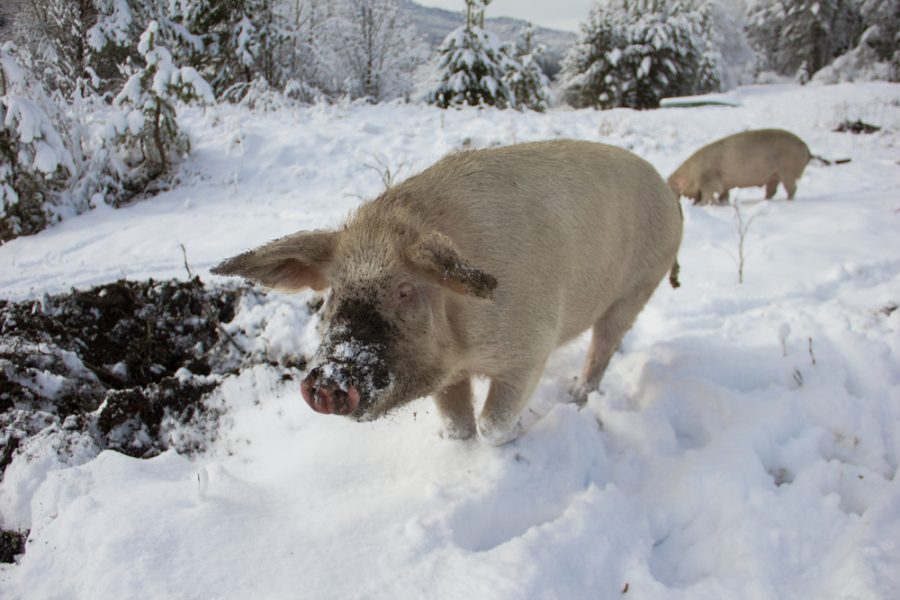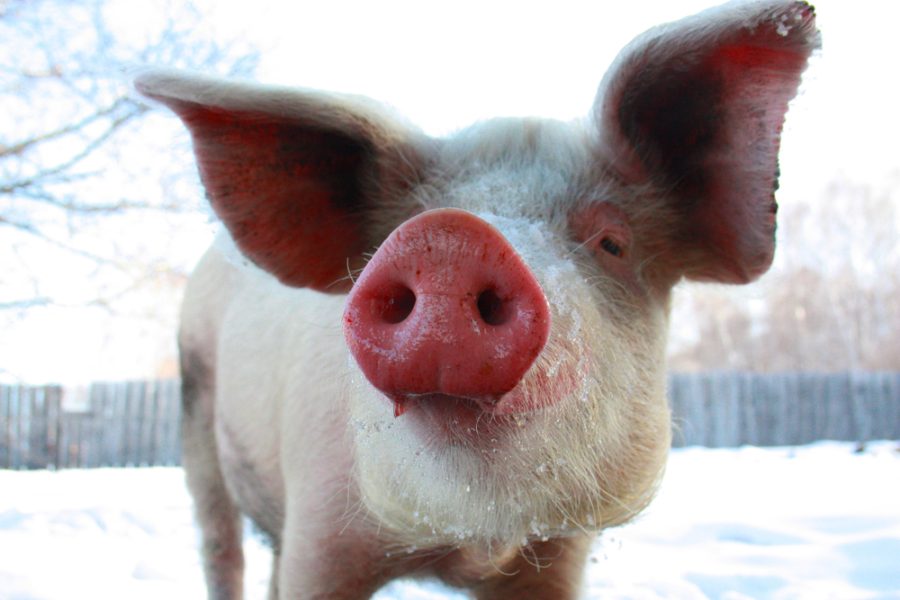Michaela Giles offers some practical hints and tips on how best to help your pigs through the coming winter, and advises keepers to act now!
It’s sometimes hard to distinguish between the seasons in the UK, but it’s always easier to prepare for a potentially harsh winter while the ground is at least somewhat firm, and the daylight hours are long. Far better that than to struggle to cope having failed to prepare.
Keeping up to date with your usual husbandry, including any vaccination and worming programmes, should be a given, so this article will focus on making your pigs as warm and safe as possible by taking all necessary steps to avoid the potential problems associated with a windy, wet or freezing winter.
Cold, damp weather is known to exacerbate underlying health conditions in pigs, and the early stages of the resultant problems can be easy to miss thanks to the darker mornings/evenings. Anyone who works and keeps pigs, will be forced to bumble about with a torch during the winter months, and it’s all too easy to make mistakes under those conditions.
If you don’t breed but buy-in fattening weaners to rear over the winter, then make sure you buy quality animals with no signs of coughing, diarrhoea, or lameness present, that have been de-wormed before departure and have been weaned from the sow for at least one week, preferably two. The most immunologically vulnerable time for a pig is in the first couple of weeks following weaning.
Good housing?
Repair those broken or ‘about to break’ arks now – we all have a couple of units that need attention, plus nothing screeches ‘winter’s here’ more than squelching around trying to fix an ark in a wet, muddy pen, in the driving rain. Likewise, if you house your pigs indoors over the winter, carry out any repairs now while you don’t have a load of pigs ‘helping you’ inside.
If you’re browsing online for a new ark, then you’ll see many different choices available; from wooden apex structures through to insulated units, with and without floors. Often, though, you have to make good with what you already have, as I do with my ordinary arks. So, to give the occupants the best chance of a comfortable time, the units need to be sited carefully.
Choose a spot that’s on level, free-draining soil (chalk/sand); heavy clay isn’t the best option. As luck would have it, my farm is on very heavy clay, but it’s workable with a bit of forethought. Place the ark in the area that’s least likely to get waterlogged, so that the bedding has a chance of staying dry, and the pigs don’t end up sleeping in a puddle. This rule applies even if the ark has a floor, because the weight of adult pigs will force the unit down into heavy, wet clay, causing water to seep up through the floorboards.
Positioning the ark in the driest area will also help encourage the pigs to get outside. If they’re forced to wade, belly-deep through thick mud to get out, then they’ll be less likely to bother to go for a regular drink, and will more likely start fouling inside. If the latter habit forms, then you’ll have to muck-out on a daily basis, to keep the bedding fresh and dry.
Arks should be orientated so that the open door isn’t facing the prevailing wind (typically westerlies in the UK). It’s important to minimise the chances of rain being driven in through the door on strong winds. To help with this, some keepers hang Hessian sacking or heavy-duty plastic strips across the opening but, more often than not, pigs will simply rip this down!
Also, bear in mind that you’ll be required to enter the winter pen regularly so, ideally, you need to make that as easy as possible. Whether you’re changing the bedding, checking on lazy pigs that haven’t got up or monitoring a farrowing sow, it’s handy if you can avoid having to take a major hike through deep mud every time to want to reach the ark. Having said that, if the best ark site for the pigs is the worst for you, then I’m afraid that the pigs have to win. So treat yourself to some good boots with zips and buckles, as they’ll be less likely to get sucked off your feet!

Bedding tips
Bedding needs to be warm and insulating. Fresh, clean straw that comes in bales is the most commonly used bedding material. Unless you have a farrowing sow – when tiny piglets can get lost and chopped straw is better – then pack the ark’s floor area full of lovely, warm straw which the pigs can burrow into when it’s cold. I know a few keepers that successfully use wood-shavings, hemp or Aubiose-type bedding, as they also have good insulating properties, but one important material to avoid is hay. Don’t use this because it’ll retain the damp, and is more susceptible to fungal spore growth which may, in turn, affect the pigs’ lungs or even cause disease.
I never use heat lamps or heat pads in my outdoor arks and find that a farrowing sow can keep her piglets perfectly warm in an ordinary ark, even when it’s snowing outside. A sow will tend to lie with her back to the doorway, so that the piglets are then able to snuggle in the draught-free warmth on the other side of her body, in the space between her front and rear legs. Even in blizzard conditions, if you put your hand inside the ark with pigs in it and plenty of good bedding, it’ll feel palpably warmer than the exterior temperature.
For growers, dry sows and boars, I rely on lots of clean, dry bedding, and ensuring there are multi-pig groups in all arks, so that the occupants can cuddle together for extra warmth. Outside, consider putting down a straw ‘doormat’ outside the ark doorway, to take off the worst of the mud from the pig’s legs as they cross it to get inside.
Heat lamps
The only time I use heat lamps is when my sows farrow indoors, and that’s a rare occurrence, reserved for prolonged minus temperatures. I also occasionally have to do it during the winter if the ground becomes water-logged in the only available pens, and there’s a risk of new-born piglets drowning if they venture outside.
While a sow can efficiently warm up a small ark, there’s no way that her body can heat a large area, such as a stable or large barn. So, for the first two-three weeks after farrowing under these conditions, I provide some additional heat. Overall, though, I’m not a fan of heat lamps or heat pads, as I think their use creates a damp and warm environment in which pathogenic bacteria can flourish. But that might not be a popular view.
The reason I switch off the heat after two or three weeks is that piglets can regulate their own body temperature from this age onwards, and so seek warmth from the pile of their litter mates as well as their mother. Adult pigs of any breed do not need heat lamps.
Smart feeding
If you can feed from outside the pen then that’s a really convenient solution. Troughs work well too, stopping the feed getting lost in the inevitable mud.
When feeding on the ground, small pellets, pencils or nuts can get lost in wet mud, so consider switching to the much larger sow rolls. I work on the basis that these take longer to disintegrate in muddy conditions, so the pigs have a better chance of finding them. Some people feed nuts in the summer and rolls in the winter for this reason.
Of course, smart keepers install a concrete feeding platform in each pen, which can make life a lot easier for them and their pigs, although I imagine that these would need scraping clean on a daily basis. In really awful weather, for the lactating sows, I sometimes use a pig mash, made in a bowl with warm water, rather than rolls. Doing this means the sow not only has a warming mash which helps her keep her weight on, but it also contains fluid which means she has to make fewer trips to the water trough – lactating sows drink more water than you think.
If you can keep pigs warm and comfortable, I find that I can feed the same amounts as I do in the summer. I do, however, keep a closer eye on body condition scores, in case they are utilising more of the food’s energy top simply keep warm.
Vital water
Providing access to continuous, fresh, palatable water is always a challenge in freezing conditions. Solid lumps of ice will need to be broken a few times a day. In the larger troughs, a fully-inflated football may provide the pigs with something to push down on to get a drink. However, if they can get hold of it, they will, so don’t rely on this method.
Providing water for smaller pigs, from the age of two weeks (which is the legal requirement), pose a bigger problem. Shallow troughs freeze quickly, and are likely to become solid ice, so keepers need to be even more vigilant, and provide multiple drinking options. It can help to use the ‘tyre and white horse bowl’ system, and to pack the empty part of the tyre with some rotted manure from the muck heap (or other, pig-safe insulating material), so then only the top tends to freeze.
Water troughs also fill with mud from the pig’s faces and feet, so silt quickly builds up and will need to be cleaned out on non-freezing days. Finally, it’s a nightmare when automatically-filling drinkers, or the entire length of hose freezes so, when you do finally get it working, fill every water container you can find and keep them in your house so that you always have back up.
Mud matters
Thick mud can trigger lameness from a pulled muscle, especially if the animal continues to play. Solid, frozen mud can also cause lameness, when pigs hurt themselves falling into a rut. In both cases, if the lameness is mild then it’s probably better for the pig to be left in the group for warmth and company, moving a water trough and feed near the entrance to the ark.
If the lameness is more severe, separation may be inevitable, but you’ll then have to keep an even closer eye on the bedding levels so a chill doesn’t set in, making the pig vulnerable to illness. Despite what I said earlier, consider the use of a heat lamp in this situation.
Pigs that are reluctant to come out in bad weather can ‘hold their bowels’, causing their faeces to become drier and leading to constipation. So, add some fresh fruit – purchased specifically, and not from your kitchen – to their diet, particularly over-ripe bananas and ripe pineapples. Another consideration is taking pigs to the abattoir; abattoirs don’t like pigs that are too muddy; it can make them more difficult to stun, and may clog the scalding tank. So, if possible, the pigs need to be contained out of the mud for a couple of days so it can drop/be brushed off.
It may be prudent, if you have the space, to build a couple of contingency pens for use when individual pens become unsuitable. During the summer, I always downsize and decide on which individuals I wish to keep in the herd, and which can be sold or sent for slaughter. This process can create a few empty pens to choose from.
To receive regular copies of The Country Smallholder magazine featuring more articles like this, subscribe here.
For FREE updates from the world of smallholding, sign up for The Country Smallholder newsletter here.








